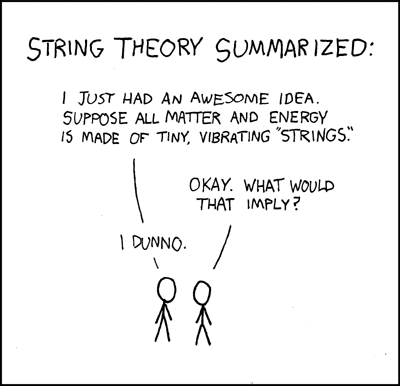Somebody said this:
duestchland1 wrote:interesting theory, but for it to even be faintly visible you would have to have an ungodly amount of debris. I find it more likely that the lasers spectrum interferes with the ever-present DARK MATTER. similar to what electricity does to neon. And since the laser is coherent, the light effect is confined to a relatively small area.
Geez. Learn your theoretical physics before you talk out of your rear.
Our current model of gravity, Einstein's General Relativity is clearly not
entirely right. It just can't predict the existence of most of the gravity we see in comparison to the amount of mass we see in the cosmos - so we label the unseen gravitational influence as "dark matter". But GR does work well for sending spacecraft around the Solar System.
Einstein had once added a Cosmological Constant to his GR equations(to prevent the Big Bang, an idea he didn't like), and a specific value for this constant would lead to the kind of gravity we see now. But once redshift was observed and the Big Bang was much more plausible, and black holes had been theorized, Einstein scrapped the CC.
The thing is, all physics that doesn't involve gravity, as well as chemistry, can be handled by the extremely accurate Standard Model of Quantum Mechanics, developed laboriously over the 20th century(and now also). BUT, once gravity is involved, everything becomes a mess. General Relativity and Quantum Mechanics contradict each other every time they meet, and something must be wrong somewhere.
In comes Quantum Gravity, the Holy Grail of modern theoretical physics. Several proposals, most notably String Theory(now M-Theory) and Loop Quantum Gravity have been put forward to combine the odd-man-out gravity with the three quantum forces(electromagnetism, strong nuclear, weak nuclear) and resolve the conflict.
Mathematically, they're all good. But experimentally, none of them has been proven. String Theory postulates that "dark matter", the excess gravitational nonsense, is caused by the lightest supersymmetric equivalents of known particles. But nobody has ever seen a supersymmetric particle, which is one of the tasks that the six-billion-dollar Large Hadron Collider(LHC) has been constructed to fulfill.
Whatever the extra gravitational influence is, it will NOT be affected by ANY kind of light or any force except for gravity - if it did, we would have found it already. Lasers are just regular light, just photons. The difference between regular light and lasers is like the difference between a bunch of people walking around randomly in a train station, and the same number of people in a marching band - one is coherent, the other is not.
But still, you don't need Quantum Gravity unless you want to try and analyze Black Holes or the Big Bang/Bounce/whatever. The only serious technological prospect for which we do not have scientific knowledge is FTL - faster than light travel and communications. For slower-than-light space travel and technology, GR and QM will do.
D00D wrote:If its too expansive and tedious to do it, than we're just not sufficently advanced to do it cheaply and efficently.
Think about it, if we never invented the wheel, we can still build the Great wall of China but at 10x the loss in human lives, resources and time.
Similarly, we will take a planet worth's of fuel and resources and possibly decades or even centuries just to blast us out of the solarsystem with our current technolodgy. Sure, we can do it, but we can do it better and more efficent if we have much more sufficent technolodgy.
So what I'm trying to say is, pratical space travel is almost impossible with our current level of knowledge, so why bother trying to apply our current notion of science to something that is so obviously science fiction?
No, we are sufficiently advanced. Just the world governments are too lazy and the corporations are getting whatever profit they need to on Earth itself, so no one really cares.
If we really want to, we can get VASIMRs up within 5 years, nuclear pulse propulsion in under 10 years, and fusion rockets up and running in the next 20 years. But the only thing that would get governments off their lazy asses is cutthroat competition. See how much aerospace tech advanced during the Space Race, and how it's been in a lull after the USSR disintegrated.
Should something motivate world governments to move, they can moot the funds to apply
known science - and "applied science" is technology. Once applied, the immense initial investment is over and we can begin space-flying.
What we are not sufficiently advanced for is interstellar travel - we've got the science to go anywhere in the Solar System, but there are only a few reasonable ways to go beyond - Antimatter Drives, Bussard Ramjets, and FTL. Antimatter Drives and Bussard Ramjets need engineering beyond our present capability, though they are scientifically possible. FTL needs quantum gravity, and a lot more - it needs
negative mass, something which we haven't even been able to hypothesize yet.







